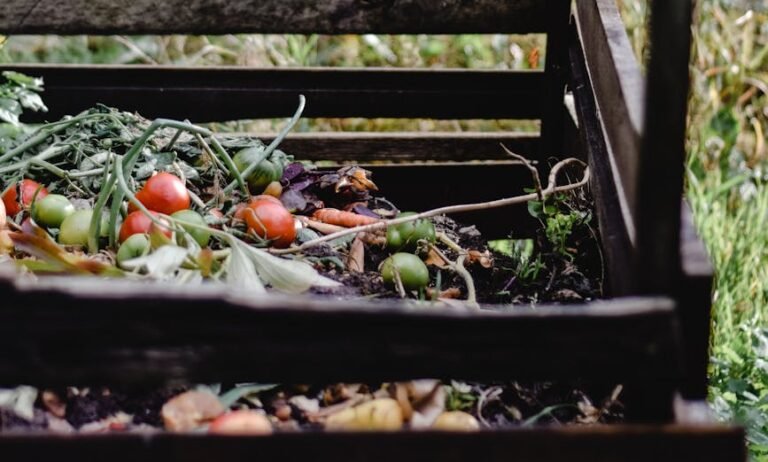Introduction to Edible Landscapes

The concept of edible landscapes represents a transformative approach to gardening that seamlessly integrates food production with aesthetic appeal. By transitioning from a traditional lawn to an organic garden, homeowners can enjoy the dual benefits of beauty and nourishment in their outdoor spaces. This idea is rooted in the philosophy of sustainability, encouraging practices that promote ecological balance while minimizing toxic environmental impact.
At the core of edible landscaping lies the belief that gardens should be both functional and visually pleasing. By incorporating a variety of edible plants such as fruits, vegetables, herbs, and even edible flowers, one can cultivate a bio-diverse ecosystem. This not only enhances the visual palette of a garden but also contributes to local biodiversity, supporting a range of beneficial insects and wildlife. By fostering such a vibrant environment, the gardener plays a crucial role in promoting sustainability.
Moreover, growing one’s own food comes with numerous health advantages. Organic produce is typically fresher and free from synthetic pesticides and fertilizers, offering a safer option for consumption. This practice encourages a diet rich in fruits and vegetables, aligning with various health guidelines advocating for increased plant-based nutrition. Furthermore, engaging in the cultivation of food can have therapeutic effects, providing a sense of accomplishment and joy through the rewarding experience of nurturing plants from seed to harvest.
Community engagement is another critical aspect of edible landscapes. By transforming lawns into community gardens or sharing produce with neighbors, individuals can foster connections and encourage collective participation in sustainable practices. This collaboration not only nourishes the body but also cultivates a sense of belonging and cooperation among community members.
Assessing Your Current Lawn

Evaluating your existing lawn is the first crucial step in transforming it into a vibrant organic edible landscape. This process involves a thorough analysis of several key factors: soil quality, sunlight exposure, drainage, and existing vegetation. Understanding these elements will not only help you identify the strengths of your current landscape but also highlight areas in need of improvement.
Begin by assessing your soil quality. Healthy soil is typically rich in organic matter and has a balanced pH. You can conduct a simple soil test, available through garden supply stores, to determine its nutrient content and acidity. This information will guide you in making necessary amendments, such as adding compost or other soil conditioners, to create an optimal growing environment for your plants.
Sunlight exposure also plays a vital role in the success of your edible garden. Observe the amount of sunlight different parts of your lawn receive throughout the day. Most edible plants require at least six hours of direct sunlight to thrive. Identifying any shaded areas is crucial, as they may need specific shade-tolerant plants or modifications, such as trimming nearby trees or shrubs to increase light penetration.
Another important factor to consider is drainage. Proper drainage prevents water-logging, which can hinder plant growth and lead to root diseases. To assess drainage, consider the slope of your lawn and how water behaves after rainfall. Areas where water pools may require amendments to improve soil structure, the installation of drainage solutions, such as French drains; or plants that thrive in such conditions.
Finally, take inventory of the existing vegetation. Identify any desirable or undesirable plants already present in your lawn. This evaluation will help you decide what to keep, remove, or potentially integrate into your organic edible landscape.
By systematically assessing these aspects, you will gain a comprehensive understanding of your current lawn, equipping you with the insights needed to initiate a successful transformation into an edible garden.
Choosing the Right Edible Plants

Transforming your lawn into a flourishing organic edible landscape begins with the careful selection of suitable edible plants. Understanding your local climate zone is crucial, as it dictates which plants will thrive in your environment. Different regions have varied growing seasons, temperature ranges, and precipitation levels that all influence plant selection. Thus, it is recommended to consult a local gardening guide or extension service to identify the best edible plants for your area.
When planning your edible garden, consider both seasonal factors and available space. For instance, early spring is ideal for planting cool-season crops such as spinach and kale, while summer months are best for heat-loving vegetables like tomatoes and peppers. Incorporating a range of plants that produce fruit at different times can ensure a continuous harvest throughout the growing season. Furthermore, integrating both annual and perennial plants may enhance the longevity and sustainability of your edible landscape.
Another important consideration is plant compatibility. Companion planting strategies can improve plant health and yield by optimizing space and deterring pests. For example, planting basil alongside tomatoes can enhance the flavor of the tomatoes and repel certain insects. Additionally, including edible herbs such as parsley or chives not only adds flavor to dishes but also attracts beneficial pollinators to your garden.
Aesthetics should also play a significant role in your plant selection. Choose edible plants that align with your desired visual appeal, incorporating a mix of foliage colors, textures, and heights. For instance, colorful Swiss chard can add vibrancy to your landscape while serving as a nutritious green. Fruits such as strawberries can be nestled among ornamental plants, allowing for both beauty and bounty. By thoughtfully selecting a diversity of edible plants, you can create an inviting and productive landscape that reflects your personal style.
Designing Your Edible Landscape

Creating an edible landscape not only provides food but also enhances the aesthetic appeal of your outdoor space. The design of your garden should prioritize both beauty and functionality, integrating edible plants seamlessly into the existing landscape. One effective approach is to establish focal points that draw the eye while serving a culinary purpose. Such focal points could include vibrant fruit trees or striking berry bushes, which create visual interest and produce delicious harvests.
Incorporating paths and borders is another critical element in the design of your edible landscape. These structures can guide visitors through the garden and also prevent soil compaction around the plants. Consider using natural materials like wood chip mulch or brick for paths to maintain a natural feel that complements the organic theme of the garden. Additionally, borders can be used to create different zones within your edible landscape, delineating areas for vegetables, herbs, and fruits while adding a cohesive structure to the layout.
Layering plants is a strategic method to maximize both yield and the beauty of your garden. This involves planting taller plants like sunflowers or tomatoes alongside shorter ones, such as leafy greens or ground covers. This vertical arrangement not only optimizes space but also provides a variety of textures and colors, enhancing the overall visual appeal of the landscape. When selecting plants, consider their growth habits and ensure that taller varieties do not overshadow dwarf plants.
Inspiration can be drawn from successful edible landscape designs, where creativity flourishes. Homeowners have transformed their yards into visually stunning edible sanctuaries that showcase diverse textures, colors, and scents. By thoughtfully integrating edible plants into your landscape design, you create an abundant garden that delights the senses while providing nourishing produce.
Soil Preparation and Enhancement

Healthy soil serves as the foundation for a thriving organic edible landscape. Before planting, it is essential to assess the soil’s current condition through soil testing. This process involves analyzing the soil’s pH level, nutrient content, and texture, which can be achieved using home testing kits or professional services. Understanding these parameters allows gardeners to determine specific amendments required to optimize soil health and promote robust plant growth.
Once the soil test results are analyzed, the next step is to amend the soil with organic matter. Incorporating materials such as well-decomposed compost, aged manure, and leaf mold can significantly enhance soil structure, aeration, and moisture retention. Not only do these organic amendments provide essential nutrients, but they also foster a healthy ecosystem of microorganisms that contribute to improved soil fertility. Aim for a compost to soil ratio of about 20-30% to ensure the best results.
Composting strategies play a vital role in soil enhancement. Establishing a compost pile at home can furnish a continuous supply of rich organic matter. A well-balanced compost should include a mix of green materials (such as kitchen scraps and grass clippings) and brown materials (like dried leaves and small sticks). Regularly turning the pile ensures aeration, which accelerates decomposition and, subsequently, nutrient availability for your edible landscape. Another important factor is to maintain proper moisture levels in the compost pile.
Additionally, utilizing natural fertilizers can further enrich soil health. Organic options such as manure, fish emulsion, bone meal, kelp extract, or humic acid provide essential nutrients without the harmful chemicals often found in synthetic fertilizers. These natural alternatives promote long-term soil fertility and maintain the ecological balance needed for a sustainable garden. Creating a nutrient-rich environment through these methods not only fosters plant growth but also establishes a vibrant ecosystem in which your organic edible landscape can flourish.
Implementing Bio-friendly Practices

Creating an abundant and beautiful organic edible landscape requires a commitment to bio-friendly practices that not only enhance plant growth but also promote health, sustainability and biodiversity. Employing water conservation strategies is paramount. Techniques such as irrigation, rainwater harvesting, and mulching can significantly reduce water consumption while ensuring that plants receive adequate hydration. By minimizing waste and maximizing efficiency, these methods prove essential in maintaining both an bio-friendly garden and a thriving edible landscape.
Crop rotation is another vital practice in organic gardening that helps maintain soil health and reduces pest and disease pressures. By alternating the types of crops planted in a specific area each season, the soil nutrient levels can be preserved, and harmful pathogens can be disrupted. This method not only boosts crop productivity but also supports biodiversity and overall ecosystem resilience.
Creating habitats for beneficial insects and birds further enhances biodiversity within the garden. By incorporating flowering plants, native species, and hedgerows, gardeners can attract pollinators and predatory insects and birds that naturally control pests. Fostering such habitats in an organic edible landscape results in a self-regulating system that supports health and productivity.
In essence, by adopting these sustainable gardening practices—such as water conservation, organic pest control, crop rotation, and providing habitats for beneficial insects—gardeners can cultivate a thriving organic edible landscape that is both environmentally friendly and productive.
Maintenance for a Thriving Garden

Maintaining a flourishing garden requires an understanding of essential care routines tailored to support an organic edible landscape. One of the most critical aspects is establishing a consistent watering schedule. Generally, gardens should receive about one inch of water per week, either through rainfall or irrigation. This ensures that plants develop strong root systems and remain hydrated. Early morning is the optimal time for watering to prevent evaporation and mold, which can harm plant health.
Another vital maintenance practice is pruning. Regular pruning helps stimulate growth, remove dead or diseased branches, and maintain the shape and size of plants. Learning how and when to prune each plant variety can enhance the health and productivity of your garden.
Harvesting practices also play a significant role in garden maintenance. Picking ripe fruits and vegetables at the right time not only enhances flavor but encourages plants to produce more. For leafy greens, continuous harvest promotes growth; however, for root crops, the perfect time is when they reach their ideal size. Additionally, monitoring for pests and diseases is crucial. Early detection can prevent extensive damage. Inspect plants regularly and utilize integrated pest management strategies to remove pests without harming beneficial insects.
Regular garden upkeep ensures a productive edible landscape. Mulching, for instance, reduces weeds, retains soil moisture, and adds organic matter to the soil. Seasonal practices, such as rotating annual crops and incorporating compost, will further enrich the soil and contribute to a more nourishing environment for your plants. By adhering to these maintenance strategies, you can cultivate a garden that is not only beautiful but also bountiful.
Harvesting and Using Your Edible Produce

Harvesting your home-grown produce brings immense satisfaction and joy, marking the culmination of your efforts in transforming your lawn into an edible landscape. Timing is crucial when it comes to harvesting crops, as this directly impacts their flavor and nutritional value. Each type of produce has its own optimal harvest time. For example, leafy greens such as spinach and lettuce should be picked before they bolt, while most root vegetables, like carrots and beets, are best harvested when they reach their full size. Observing color, texture, and size are essential indicators for peak readiness.
To ensure the best quality, it’s important to use the right harvesting techniques. For instance, plucking fruits and vegetables gently from their plants helps prevent damage, allowing for extended shelf life. Using sharp gardening shears or knives can also minimize stress on the plant, promoting further growth. Besides, harvesting in the morning after dew has dried enhances the freshness and flavor of the produce.
Once you’ve harvested your ingredients, the possibilities for utilization are vast. Fresh vegetables can be incorporated into wholesome meals, salads, and smoothies, offering maximum nutritional benefits. Consider experimenting with new recipes; for instance, freshly picked herbs can elevate the flavor of pasta dishes or stews. Preserving your harvest is also an excellent method to enjoy seasonal abundance throughout the year. Canning, freezing, and dehydrating are effective ways to store produce while maintaining its nutrition. For instance, tomatoes can be canned into sauces, while excess fruits can be frozen for use in smoothies or desserts.
Ultimately, this mindful process of harvesting and utilizing edible landscaping not only enriches your diet but also fosters a deeper connection with nature. By embracing sustainable practices, you contribute to a more robust ecosystem right in your backyard.
Community Engagement and Sharing Abundance

Transforming a conventional lawn into an organic edible landscape not only enhances personal spaces but also serves as a bridge for community engagement. One of the most rewarding aspects of cultivating an edible garden is the opportunity to share the surplus produce with neighbors. This practice fosters a spirit of generosity and encourages individuals to become more connected with their local environment. Sharing homegrown fruits, vegetables, and herbs not only enriches the diets of community members but also strengthens relationships within the neighborhood.
Participating in local gardening groups or farmer’s markets can further amplify these community connections. Such platforms offer an excellent opportunity for individuals to exchange gardening tips, share experiences, and even barter or sell surplus harvests. By becoming active in these local networks, individuals can not only showcase their own edible landscapes but also gain inspiration and support from like-minded peers. Additionally, the act of selling or trading produce contributes to the promotion of local food systems, ensuring fresh and organic options are more readily available to everyone.
Engagement in community-supported agriculture (CSA) is another effective way to deepen these connections. Through CSA, community members can invest in local farms, receiving fresh, seasonal produce directly from growers. This model not only provides economic sustainability for farmers but also strengthens ties between consumers and producers, fostering a greater understanding of the food production process. As people become more involved in these initiatives, a sense of collective responsibility towards healthy, sustainable local food systems develops.
Incorporating these community aspects into edible gardening nurtures relationships, promotes food security, and encourages sustainable practices, leading to a more interconnected and environmentally conscious community.




The Hidden Truth About Where Your Food Really Comes From Will Shock You